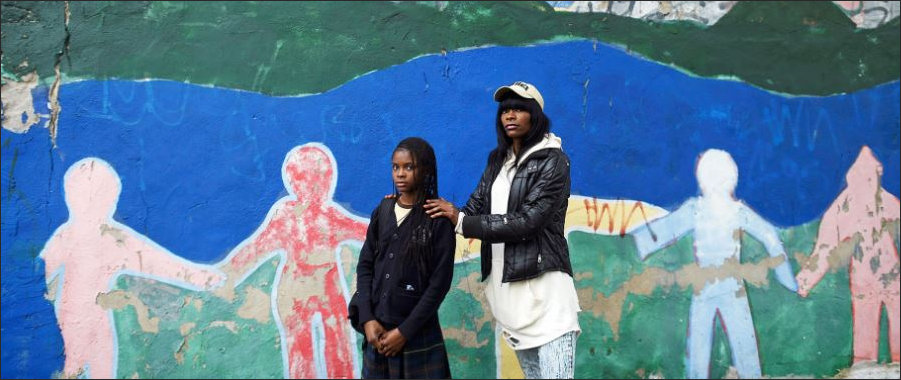
Lakisha Johnson and daughter. Photo credit: Reuters
Politicians had the best of intentions when they crafted policies to make higher education more accessible to everyone by handing out generous student loans. But they ended up plunging millions of Americans deep into debt and subjecting them to relentless efforts to recover that debt.
A Reuters investigation into student loan debt collections highlights the plight of a Philadelphia woman, Lakisha Johnson.
Lakisha Johnson figured all she needed was her 2016 tax refund to get her and her daughter out of a homeless shelter and back into a place of their own.
The U.S. Department of Education had other plans.
Johnson, a home health aide, and 12-year-old Aijiah were forced to move out of their West Philadelphia apartment just before Thanksgiving last year, after the landlord jacked up the rent from $675 to $875. Soon, they were living on a bunk bed in the shelter a few blocks from Aijiah’s school. The girl was petrified that a classmate would see her using the secured entrance of the crowded, noisy shelter.
With the $13 an hour she earns caring for her elderly charges, Johnson planned to stay at the shelter — or with anyone who would let the two sleep on a floor, a couch or a spare mattress — until April. In past years, that’s when she received her federal Earned Income Credit tax refund.
The check never came.
On the phone, an Internal Revenue Service agent told her the Department of Education (DOE) was “holding back” the $8,220 refund to recoup some of her student loan debt. It would probably do the same next year, the agent told her, to recover the rest of the nearly $17,000 she owed.
Johnson is just one of eight million borrowers in the United States who are in default on a combined $137.4 billion in government-held or government-backed student loans. Eleven percent of all student debt is severely delinquent or in fault, a higher rate than the mortgage foreclosure rate at the peak of the sub-prime real estate bust. But unlike mortgages, a form of debt that can be discharged, there is no way to shake student loans.
Since the summer of 2015, Reuters has found, student loan servicers and private debt collectors have garnished about $3 billion in wages. And last year, tax refund seizures and Social Security benefit reductions amounted to another $2.6 billion, up from $2.2 billion in 2015. Since 2009, the federal government has clawed back at least $15.2 billion. Writes Reuters:
Default, which usually occurs when a borrower hasn’t made a payment for 270 days or more, can make it only harder for a debtor to regain financial stability. It can trash credit scores, scaring off potential employers. It can disqualify debtors for auto loans, apartment rentals, utilities and even cellphone contracts. In about 20 states, student loan borrowers who default can lose their driver’s and professional licenses.
Needless to say, those impacted from the student debt-collection regime are disproportionately poor and minorities.
The Reuters article focuses mainly on the aggressive tactics of debt collectors and the failure (or refusal) to inform many debtors of all of their options, such as shifting to a plan that limits repayments to a percentage of income. In effect, the debt collectors come across as the “bad guys” in the story.
But Reuters does quote Jack Remondi, CEO of Navient Corp., a loan servicer operating under contract with the Department of Education:
Remondi blamed rising student loan defaults on “the front end of the process,” such as the government policy of lending to borrowers regardless of their credit standing and without consideration of “whether the investment they are making is reasonable.”
Bacon’s bottom line: That is the root of the problem. Under the guise of creating opportunities for the poor, the government policy of treating access to higher education as a “right” and indiscriminately handing out loans to unsophisticated consumers turned millions of Americans into debt peons. Government policy made their condition worse. Government policy, far from liberating the American poor, is grinding many into deeper poverty. Between shoveling out student loans and stoking the issuance of sub-prime mortgages a decade ago, misguided policies emanating from the good intentions of federal policy makers have shattered the lives of millions of poor. (Don’t get me started on the issues of under-performing schools and the mal-incentives of the welfare state.)
Meanwhile the poverty-creation machine chugs on unperturbed in Virginia. Here is data from the State Council of Higher Education for Virginia encompassing public four-year colleges, private four-year colleges, and community colleges:
- 10% of from first-time-in-college students dropped out after the first year of enrollment.
- 40% of those students had debt, which averaged $8,036. The wages of college drop-outs the following year averaged $12,500.
All told, 36% of students at 20% of the poverty line and below fail to graduate. College loans, it must be said, also have allowed many students to lift themselves out of poverty, so it would be a mistake to dismantle the entire system. But student lending is in desperate need of reform. Good intentions are not enough.


